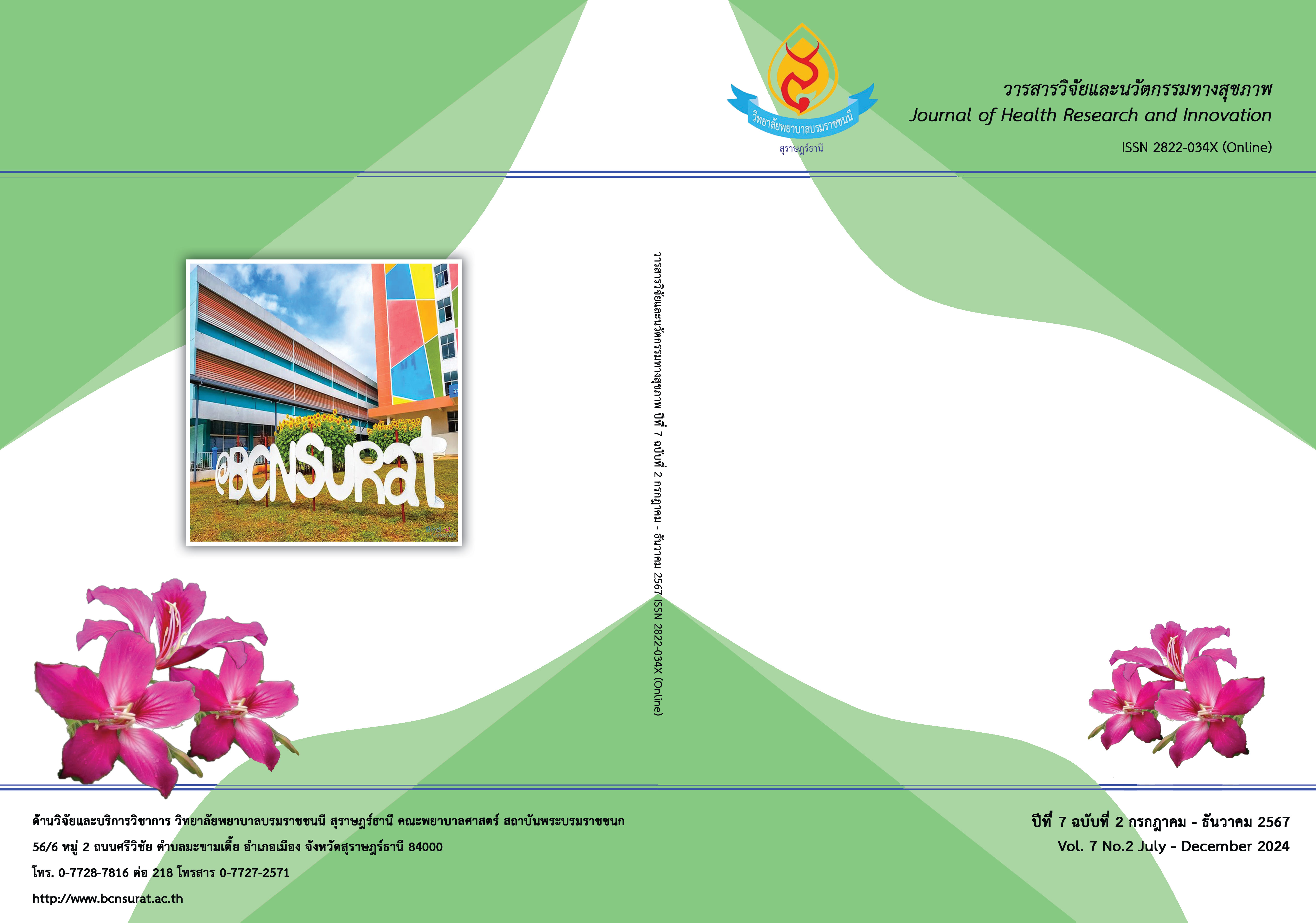การจัดการอาการ และอาการปวด หลังการเป็นโรคหลอดเลือดสมอง
คำสำคัญ:
โรคหลอดเลือดสมอง, อาการปวดหลังการเป็นโรคหลอดเลือดสมอง, การจัดการอาการบทคัดย่อ
โรคหลอดเลือดสมองเป็นกลุ่มอาการทางระบบประสาทเกิดจากการอุดตัน ตีบ หรือแตกของหลอดเลือดที่ไปเลี้ยงสมอง ทำให้เนื้อเยื่อบริเวณนั้นขาดเลือดไปเลี้ยงเซลล์สมองส่วนนั้นอาจตายได้ส่งผลไปถึงการสูญเสียหน้าที่ของอวัยวะในร่างกายที่อยู่ภายใต้การควบคุมของสมองส่วนนั้นๆ โดยภาวะแทรกซ้อนที่พบตามมาคืออาการปวดหลังการเป็นโรคหลอดเลือดสมอง เป็นอาการปวดที่เกิดจากระบบประสาททำงานผิดปกติ และ อาการปวดที่เกิดจากการบาดเจ็บของเนื้อเยื่อ ซึ่งการจัดการอาการปวดมี 2 วิธี คือการจัดการอาการปวดโดยใช้ยา ได้แก่ กลุ่มยาแก้ซึมเศร้า กลุ่มยากันชัก กลุ่มยาคลายกล้ามเนื้อ ยา Benzodiazepines และยา Botulinum Toxin การจัดการอาการปวดโดยไม่ใช้ยา ได้แก่ การฝังเข็ม การนวดแผนไทยหรือแผนโบราณ การประคบ การกระตุ้นด้วยไฟฟ้า และการพันผ้าเทปพยุงไหล่
บทความวิชาการมีวัตถุประสงค์เพื่อทราบถึงอาการปวด หลังการเป็นโรคหลอดเลือดสมอง และการจัดการอาการเพื่อพัฒนาและส่งเสริมคุณภาพชีวิตของผู้ที่เป็นโรคหลอดเลือดสมอง แนวทางการจัดการอาการที่สามารถปฏิบัติได้ด้วยตนเอง รวมถึงวิธีการที่อาศัยความร่วมมือจากบุคลากรด้านสุขภาพ ส่งผลให้ผู้ที่เป็นโรคหลอดเลือดสมองมีคุณภาพชีวิตที่ดีขึ้น
เอกสารอ้างอิง
A P Hansen, N S Marcussen, H Klit, G Andersen, N B Finnerup, T S Jensen. (2012). Pain following stroke: a prospective study. Eur J Pain, 16(8), 1128-1136.
Alan Carter. (2023). The benefits and risks of benzodiazepines. https://www.medicalnewstoday.com/articles/262809
Bhalla, A., & Birns, J. (2015). Management of post stroke complications. Springer, Cham.
Boonkong, D. (2019). Enhancing Swallowing Safety in Stroke Patients with Dysphagia: A Challenging Role for Nurses. Journal of Boromarajonani College of Nursing, Bangkok, 35(1), 13-23. (in Thai)
Chohan, S.A., Venhatesh, P.K., & How, C.H. (2019). Long-term complications of stroke and secondary prevention: an overview for primary care physicians. Singapore Medical Journal, 60(12), 616-620.
Ewa Jaraczewska & Carol Long. (2006). Kinesio taping in stroke: improving functional use of the upper extremity in hemiplegia. Topics in Stroke Rehabilitation, 13(3), 31-42.
Harrison, R.A., Field, T.S. (2015). Post Stroke Pain: Identification, Assessment, and Therapy.Cerebrovascular Diseases, 15(39), 190-201.
Hannah Payton, Andrew Soundy. (2020). The Experience of Post-Stroke Pain and The Impact on Quality of Life: An Integrative Review. Behav Sci (Basel), 10(8), 128.
Jitprapaikulsan, J., Prayoonwiwat, N.,. (2022). Neuromyelitis optica. https://www.si.mahidol.ac.th/th/healthdetail.asp?aid=1236 (in Thai)
Junwibun, W. (2020). The Treatment of Paralysis in The Recipe of Thai Traditional Medicines. UMT-Poly Journal, 17(1), 44-49. (in Thai)
Kittiwarawut, J. (2018). Reducing spasticity in adults with stroke. Burapha Journal of Medicine, 5(2), 131-141. (in Thai)
Kuptniratsaikul, V., Kovindha, A., Suethanapornkul, S., Manimmanakorn, N., & Archongka, Y. (2013). Long-term morbidities in stroke survivors: a prospective multicenter study of Thai stroke rehabilitation registry. BioMed Central Geriatrics, 13, 33. hrrp://www.biomedcentral.com/1471-2318/13/33
Langhorne, P., Stott, D.J., Robertson, L., MacDonald, J., Jones, L., McAlpine, C., et al.,. (2000). Medical complications after stroke: A Multicenter study. Stroke, 31, 1223-1229.
Lerdsintai, P. (2019). Electrotherapy for Physical Therapists (1). Naresuan University Publishing House. (in Thai)
M Dodd, S Janson, N Facione et al. (2001). Advancing the science of symptom management. JAN leading global nursing research, 33(5), 668-676.
Mongaew, P. (2018). Serotonin syndrome. Thai Journal of Hospital Pharmacy, 28(2), 102-113. (in Thai)
National Institute for Emergency Medicine. (2022). Emergency Medical Services Situation Study and Literature Review on Quality Development of Emergency Operations for Stroke Patients. (in Thai)
Neurological institute of Thailand. (2018). Guideline of Endovascular Treatments in Patients with Acute Ischemic Stroke. (in Thai)
Omudhome Ogbru. (2014). Most Common Antidepressants for Depression: Types and Side Effects. https://www.emedicinehealth.com/understanding_antidepressant_medicatio
Pitiyan, S. (2019). Nursing care for patients with Behavioral and Psychological Symptoms of Dementia:BPSD.https://www2.si.mahidol.ac.th/division/nursing/sins/attachments/article/.pdf
Posai, V. (2021). Management of post-stroke pain. Chiang Mai Medical Journal, 60(4), 841-854. (in Thai)
Raghavan, P. (2015). Upper Limb Motor Impairment Post Stroke. Phys Med Rehabil Clin N Am, 26(4), 599-610.
RACHEL BAXTER. (2019). What Causes Those Sharp, Stabbing Pains You Get Every So Often In Random Body Parts?. https://www.iflscience.com/what-causes-those-sharp-stabbing-pains-you-get-every-so-often-in-random-body-parts-53012
Ralph L Sacco, Scott E Kasner, Joseph P Broderick, Louis R Caplan, J J Buddy Connors, Antonio Culebras, et al.,. (2013). An updated definition of stroke for the 21st century: a statement for healthcare professionals from the American Heart Association/American Stroke Association. Stroke, 44(7), 2064-2089.
Rebecca A Harrison, Thalia S Field. (2015). Post stroke pain: identification, assessment, and therapy. Cerebrovascular Diseases, 39(3), 190-201.
Sirikamonsathian, B., Skuntaniyom, A. (2018). Effects of Self-Massage on Pain Among Elders in Rimklong Lorlae Community, Khannayao District. Songklanagarind Journal of Nursing, 38(3), 92-101.
Stroke Foundation. (2017). Pain after stroke. https://strokefoundation.org.au/media/urlb0xb1/pain-after-stroke.pdf
Tontisirin, N. (2021). Basic Pain Control. https://www.rama.mahidol.ac.th/graded/sites/default/files/public/High_Diploma/handout_HD/handout_HD701/handout_HD64/Basic_pain180821.pdf (in Thai)
Wannawibool, B., Danaiswat, P., Kiartivich, S., Noomhorm, N., Wannawibool, N., Chiaopromkun, T., et al.,. (2020). Comparison of the Effectiveness of Manually Stimulated and Electrically Stimulated Scalp Acupuncture in Patients with Lower Back Pain: A Randomized Controlled Trial. Journal of Thai Traditional & Alternative Medicine, 18(3), 521-534. (in Thai)
ดาวน์โหลด
เผยแพร่แล้ว
รูปแบบการอ้างอิง
ฉบับ
ประเภทบทความ
สัญญาอนุญาต
ลิขสิทธิ์ (c) 2024 วิทยาลัยพยาบาลบรมราชชนนี สุราษฎร์ธานี

อนุญาตภายใต้เงื่อนไข Creative Commons Attribution-NonCommercial-NoDerivatives 4.0 International License.
บทความที่ได้รับการตีพิมพ์เป็นลิขสิทธิ์ของวารสารวิทยาลัยพยาบาลบรมราชชนนี สุราษฎร์ธานี
ข้อความที่ปรากฏในบทความแต่ละเรื่องในวารสารวิชาการนี้เป็นความคิดเห็นส่วนตัวของผู้เขียนแต่ละท่านไม่เกี่ยวข้องกับวิทยาลัยพยาบาลบรมราชชนนี สุราษฎร์ธานี และคณาจารย์ท่านอื่นๆในวิทยาลัยฯ แต่อย่างใด ความรับผิดชอบองค์ประกอบทั้งหมดของบทความแต่ละเรื่องเป็นของผู้เขียนแต่ละท่าน หากมีความผิดพลาดใดๆ ผู้เขียนแต่ละท่านจะรับผิดชอบบทความของตนเองแต่ผู้เดียว



